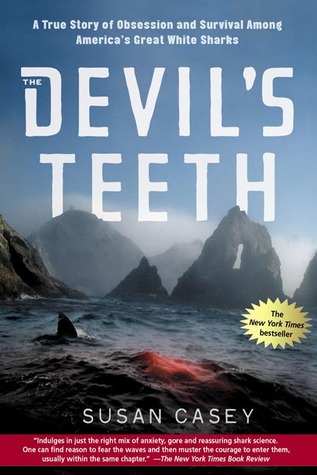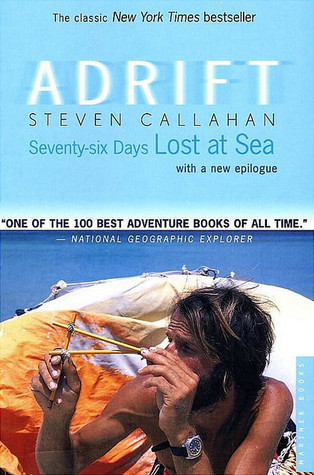I was disappointed by The Devil’s Teeth by Susan Casey. I wanted to like it. I actually enjoyed the story and I still recommend reading it. Casey is a great writer who makes her audience feel involved with her story. However, I had an uneasy feeling about her involvement in this project from the beginning of the book and the epilogue only confirmed my fears, that her presence on the islands was more than just journalistic interest, that she was using her position as a reporter to gain access to a world that was set up to keep her out.
The Devil’s Teeth is the story of the modern great white shark research program on Southeast Farallon Island. She begins the book with the story of some of the scientists on the island and the sharks that they are studying. She dives into a bit of the history of humans on the islands, the history of certain animal populations there, and why access to the islands is restricted. I’ve been out there on a very nice day where we were able to motor around the island and see most of it’s defining landmarks so I was able to visualize her time out there. I have never seen a shark attack (in the Farallons or elsewhere) so I cannot relate to her obsession with seeing another.
Access to the islands is very heavily regulated but Casey talks herself into an intern position so she can spend a season on the island helping with the shark project and researching her story. I didn’t have a problem with this, media plays a powerful role in conservation work and her story did raise a lot of awareness for shark issues. However, while back in Manhattan she becomes obsessed with getting back on the island. She gets a day pass during bird nesting season and can’t hide her disappointment that she doesn’t see a shark. I understand that certain events are more powerful than others but Casey becomes so obsessed with being on Southeast Farallon Island and seeing a Sister, one of the large adult females, that she puts the entire shark program in jeopardy. In conjunction with the researchers she secures a yacht to use as a water based research station during shark season. Since permits are not needed to live aboard a yacht just off the island she stays on the yacht while the researchers live on the island. She admits to abusing the compassion of one of the researchers when she begs him to let her walk on solid land after being cooped up on the yacht for weeks. She puts her own need to see a Sister attack above her extremely accommodating hosts and the program’s existence.
She is so obsessed with the shark story that she doesn’t do much research on anything else happening on the island. She acknowledges that the Point Reyes Bird Observatory runs a major research program on the islands yet she seems dismissive of the work being done, almost implying that it’s just something to do between shark attacks. She brings up the story of some sea lions that were released near the islands by “a well-meaning boatload of people” which were promptly chomped on by a waiting great white shark. The way she recounts this incident you would think that a random group of people picked up two sea lions on the beach, brought them back to their bathtub, then, once they were fat enough, back to the Farallons. She seems unaware of the fact that that “well-meaning boatload of people” are marine mammal scientists who run a world renowned research facility and animal rehabilitation center. She also never bothers to ask why two sea lions might be released at the Farallons instead of someplace far more convenient and less stressful for the animals. Farallon releases are generally reserved for sea lions that are so habituated to human presence that they are a danger to themselves and others if they are released on the mainland. She also dismisses offhand some swimmers who want to do a relay from the islands to the Golden Gate. The idea of someone swimming at the Farallons “disturbed [her] so much that [she’d] phoned one of the organizers.” She doesn’t try to dig any deeper to find out what type of due diligence these swimmers may have done. This relay did happen and several others (before Casey’s time on the island and after) have swum it solo. It is an incredibly challenging swim but it is possible. If you want to see video of this happening and the type of safety that goes into these swims, check out Kim Swims on Netflix or From the Golden Gate to the Farallons.
I finished this book wishing that Casey gave a more heartfelt apology. She admits that she got carried away and feels remorse for what happened but given how much of the book is dedicated to her obsession it just seems like she is paying lip service to mollifying readers like me who can’t believe that this really happened. If this were fiction I would say this was a fantastic book. However, because she doesn’t do much to teach the reader about anything other than sharks and she actually put a world class research operation at risk for her own personal gain, I have a hard time liking this book. That being said, I think it is worth reading as it is a good reminder of why following the rules is important, whether or not you agree with them, and that pursuing your obsession at any cost may ultimately hurt the object of your obsession.



